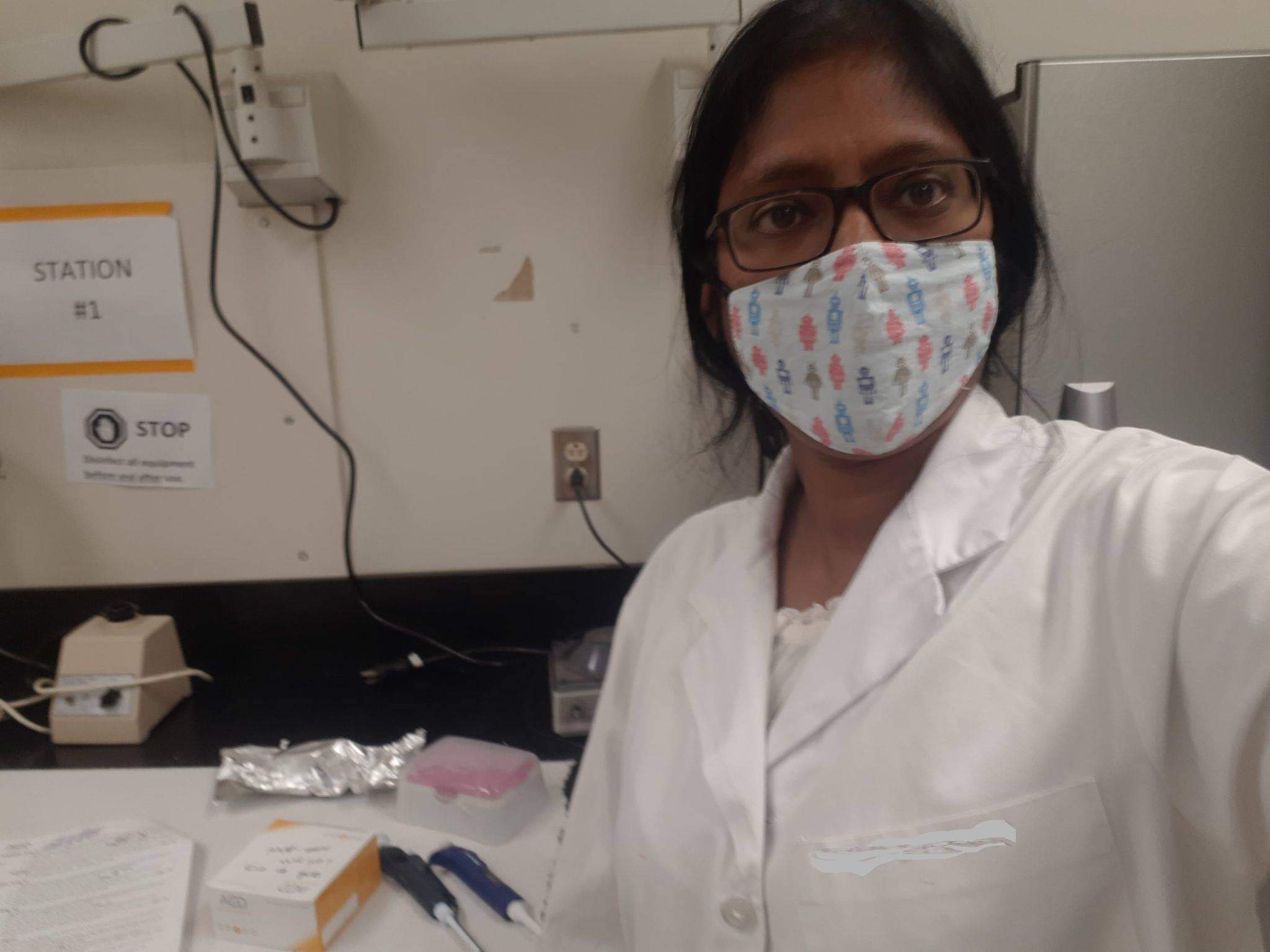|
In this Issue...
- Selected Posters from the Recent Online Poster Session
- Annual Meeting of the IBNS (IBNS 2021) in Puerto Vallarta, Mexico
- Accepted Symposia for IBNS, 2021
- From the Ethics and Diversity Committee
- Recent Trends in Behavioral Neuroscience
- Guest Editor Profile - Dr. O Chandani Dinesh
Selected Posters from the Recent Online Poster Session

Compiled by Dr. Millie Rincón-Cortés
Research Assistant Professor, Grace Laboratory,
Department of Neuroscience
A210 Langley Hall
University of Pittsburgh
Pittsburgh, PA 15260
Dr. Rincón-Cortés completed her doctoral degree at the NYU Medical Center prior to completing a postdoctoral fellowship at the University of Pittsburgh studying stress-induced plasticity within the mesolimbic DA system. She was recently promoted to research faculty and is currently focused on studying normative and stress-induced adaptations in the female dopamine system during the postpartum.
Poster title: Diet-induced obesity alters sweet taste preference and brain reward circuitry in rats
Presenter: Michael D. Kendig
Obesity is a growing public health concern that is linked to metabolic and cognitive impairments as well as disrupted reward-related brain activity. To better understand obesity-induced plasticity within the reward system, the authors used a rat model to determine the effects of diet-induced obesity on sweet taste preference as well as the expression of phosphorylated extracellular signal regulated kinase (pERK, an index of neuronal activity) in brain regions involved in taste perception and reward processing, such as the insular cortex and nucleus accumbens, respectively. Their obesity model consisted of feeding adult male rats with standard chow (control group) or a western-style cafeteria diet (experimental group) for approximately 3 months. Rats exposed to the cafeteria diet had tripled their energy intake and doubled their body weight gain. Under water restriction, control rats consistently preferred higher concentrations of sucrose (i.e., 32% > 8% > 2%) solution, whereas cafeteria-diet rats were indifferent to the two lower concentrations and increased preference for 32% vs. 2% while making fewer licks for all concentrations, regardless of motivational state, suggesting motivational deficits. Rats were then exposed to a novel concentration of sucrose solution (20%) and transcardially perfused for immunofluorescent staining. Rats that were fed the cafeteria diet showed decreased pERK expression in the nucleus accumbens shell and insular cortex, which is consistent with the notion that high-fat palatable diets alters preference for and brain activity in response to future rewards.
Poster title: How oxytocin and vasopressin influence the making and breaking of family bonds
Presenter: Caleigh D. Guoynes
Social relationships are beneficial for humans and mammals. Thus, there has been a growing interest in how social bonds are formed, maintained and broken. Oxytocin and vasopressin are neuropeptides involved in social behavior and that have critical roles in partner and parental bond formation. However, less is known about the roles that these neuropeptides play in bond maintenance and breakdown. The California mouse is a biparental, monogamous species that can simultaneously maintain a socio-sexual (i.e. partner bond) bond while forming and breaking parental bonds with offspring. Using this mouse, the authors examined the role oxytocin and vasopressin in juvenile preference for their parents. Juveniles were given a social preference test consisting of a chamber with their parents, a chamber with novel peers (one male, one female), or an empty chamber. In juvenile males, oxytocin administration enhanced social preference for their parents. This effect was absent in females. Moreover, vasopressin did not alter social preference for either females or males. Furthermore, neither oxytocin nor vasopressin influenced behavior on the elevated plus maze or a novel object task, suggesting effects are specific to social behavior. Taken together, these results suggest that oxytocin in juvenile males may be part of the mechanisms underlying parent-offspring bond maintenance.
Poster title: Cotinine and 6-hydroxy-L-nicotine improves neurobehavioral changes and reduce oxidative stress in a zebrafish (Danio rerio) model of Alzheimer's Disease
Presenter: Razvan Boiangiu
Alzheimer's Disease (AD) is a neurodegenerative disorder characterized by cognitive decline, mood changes and loss of forebrain cholinergic neurons. Zebrafish are emerging as an increasingly successful model for translational research on human neurological disorders and have even been successfully used to simulate AD pathology. For example, the authors used a zebrafish model of AD induced by scopolamine (SCOP), which results in memory deficits, anxiety-like behavior and oxidative stress. The presence of nicotinic acetylcholine receptors (nAChRs) in the cholinergic neurons suggests their involvement in memory, learning, and cognition and may play a role in the observed effects. Nicotine, a nAChR agonist has been shown to improve memory, attention, and learning; however, its therapeutic use in AD is limited by cardiovascular and addictive side-effects. For this reason, the authors investigated the effects of two structural related nicotine derivatives, cotinine (COT) and 6-hydroxy-L-nicotine (6HLN), which were administered acutely via immersion, on the behavioral sequelae observed in their zebrafish model of AD. They also we evaluated the impact of COT and 6HLN on oxidative stress by measuring the level of reduced glutathione (GSH) and carbonylated proteins. Both 6HLN and COT improved memory in Y-maze and novel object recognition tasks and reduced the anxious behavior in novel tank diving test. In addition, 6HLN and COT increased the content of GSH and decreased the level of carbonylated proteins, suggesting that COT and 6HLN reduce the oxidative stress in SCOP-treated zebrafish. Collectively, these findings show that COT and 6HLN mitigate scopolamine-induced anxiety and memory deficits in zebrafish and promote antioxidant action.
Poster title: Immune challenge in mid pregnancy causes sex-specific behavioural changes in adult mouse offspring, reminiscent of neuropsychiatric disorders.
Presenter: Anna Yotova
Maternal immune activation (MIA) in rodents is a widely used model for neurodevelopmental psychiatric disorders. In this study, MIA was induced by administering pregnant C57Bl/6J wild-type dams with varying doses (0, 2.5 and 5mg/kg) of the viral mimetic poly (I:C) on gestational day 9 to study the behavioral effects MIA effects on adult male and female offspring. Adult female mice born to dams receiving the highest dose (5mg/kg) exhibited novelty-induced hyperactivity and anxiolytic effects in the Y-maze. With regards to negative affect, males exhibited increased anhedonia, as indexed by reduced sucrose preference. Robust impairments in social function (deficits in social interaction and recognition) were detected adult mice of both sexes. Yet, no spatial or object memory deficits were found in either sex. These results suggest that MIA produces long-lasting and sex-dependent effects on a subset of offspring behaviors, the most robust being disrupted social behavior while sparing others (i.e. spatial/object memory). Thus, these findings suggest that MIA is useful for modeling social dysfunction commonly observed across multiple psychiatric disorders.
Back To Top
Annual Meeting of the IBNS (IBNS 2021) in Puerto Vallarta, Mexico
IBNS 30th Annual Meeting
Puerto Vallarta, Mexico
June 1 - 5, 2021
Important Dates
Symposia Proposals October 19, 2020
Travel Award Applications December 6, 2020
Abstract Submissions February 2, 2021
 Fair M. Vassoler, PhD. Fair M. Vassoler, PhD.
Assistant Professor, Tufts University
Cummings School of Veterinary Medicine
Department of Biomedical Sciences
200 Westboro Rd.
Hello, IBNS community! I don’t know about the rest of you, but I really miss attending conferences right now. I am just itching to travel, talk about behavioral neuroscience, and make new connections. That is why I am so excited about the IBNS 2021 conference next year in Puerto Vallarta, Mexico. Even if the conference doesn’t move forward in the traditional sense, I am still daydreaming of attending the excellent symposia, hearing amazing keynotes, networking with colleagues new and old, and taking trips to warm and sunny beaches. Luckily, the IBNS team is preparing for all eventualities with options for hybrid presentations and attendance. Check out the section in this newsletter that highlights some of the posters from our 2020 virtual conference for a taste of what you can get. My name is Fair Vassoler and I am the chair of the Membership and Communications Committee (MCC) for IBNS. I have been working with my amazing co-chairs, Lizzie Manning, Daphne Ling, and Donald McEachron during these strange and difficult times. I feel so lucky to be part of this great society, particularly during these challenging times. IBNS is comprised of dedicated scientists that support each other and engage in meaningful conversations about science, ethics, diversity, inclusion, and life through good times and bad. I want to highlight here some of the initiatives that the MCC is pursuing as well as some of the exciting symposium we have accepted for the 2021 meeting in beautiful Puerto Vallarta, Mexico.
The Membership and Communications Committee's mission is to assist the Council with the multiple issues associated with recruiting, maintaining, and communicating with members in the IBNS. The MCC is committed to promoting the main goals of IBNS, which is fostering a positive relationship with the lay public, scientists, and organizations involved in the neurosciences, and the potential scientific and therapeutic benefits of behavioral neuroscience. From the membership perspective, over the last year or so we've been trying to find ways to increase international representation in the society, with a particular focus on South and Central America in the lead up to the meeting in Mexico next year. We especially want to emphasize the discounted membership rates that are available in a number of countries. We also believe that the hybrid meeting model (next year and beyond) can increase access for people in regions where conference funding support is less obtainable. While we anxiously await the ability to travel and confer, you can still stay up-to-date on the latest behavioral neuroscience news. Check out the IBNS daily news on the IBNS website. Curated news designed for you http://dailynews.ibnsconnect.org/#/. Is there something else that you want to get out of IBNS? Do you have ideas for future conference or ways to connect remotely? Let us know! (@IBNSconnect)
I hope you do decide to stay connected with IBNS and join us for the 2021 conference. For even more enticement, the following symposia are already accepted and will be delivered to you in June next year. Additionally, the program committee is working hard going through new submissions so this list of great topics will only grow!
.
Back To Top
Accepted Symposia for IBNS 2021
IBNS Program Committee is currently reviewing additional Symposia Proposals and is excited to be adding to this outstanding list.
Neuroscience of Maternal Mental Illness. Chair: Jodi Pawluski. Speakers: Elseline Hoekzema, Benedetta Leuner, Joseph Lonstein, Jodi Pawluski
Using Stress-Enhanced Fear Learning to Reveal Associative and Nonassociative Consequences of Traumatic Stress. Chairs: Michael Drew; Susan Sangha. Speakers: Abha Rajbhandari, Moriel Zelikowsky, Andrew Poulos, Michael Drew.
Contributions of the Cingulate-Retrosplenial Cortical Axis to Learning and Memory Consolidation. Chairs: Nicole Ferrara; Janine Kwapis. Speakers: Nicole Ferrara, Aaron Jasnow, Sydney Trask, Janine Kwapis.
Clinical and Experimental Assessment of Behaviors Associated with Dementia: Challenges and Solutions. Chairs: Farida Sohrabji; Gregory Bix. Speakers: Terry Quinn, Marion Buckwalter, Jerome Badaut, Aditya Panta, Masafumi Ihara.
Origins of Sex Differences in Behavior: The Unusual Suspects. Chairs: Debra Bangasser; Georgia Hodes. Speakers: Marianne Seney, A.J. Robison, Georgia Hodes, Debra Bangasser.
Neural Systems Regulating Responses to Stress, Threat, and Safety. Chairs: Ryan LaLumiere; Heidi Meyer. Speakers: Jason Radley, Michael Baratta, Susan Sangha, Heidi Meyer.
A New Perspective on the Role of the Insular Cortex in Cognition and Behavior Based on Pre-Clinical Research. Chairs: John Christianson; Anna Beyeler. Speakers: Yoav Livneh, Nadine Gogolla, John Christianson, Anna Beyeler.
Memory and Plasticity in Development and Maturation - Periods of Vulnerability and Opportunity. Chair: Jee Hyun Kim. Speakers: Paul Frankland, Judy Sng, Yvonne Nolan, Jee Hyun Kim.
Glial Control of Neuronal Plasticity and Behavior. Chairs: Pavel Ortinski; Jill Turner. Speakers: Kathryn Reissner, Jill Turner, Annalisa Scimemi, Pavel Ortinski.
The Role of the Environment on the Penetrance of Neuro Developmental Disorders. Chairs: Lorenzo More; Lucia Privitera. Speakers: Victorio Bambini-Junior, Carmem Gottfried, Lucia Privitera, Lorenzo More.
Hormone-Mediated Neuroplasticity Across Behaviors. Chairs: Laura Been; Liisa Galea. Speakers: Erica Glasper, Laura Been, Liisa Galea, Paul Sheppard.
Reward Seeking vs Addiction: Exploring the Phenotypes of Substance Use Disorder Using Rodent Models. Chairs: Christina Perry; Andrew Lawrence. Speakers: Bianca Jupp, Christina Perry, Nathan Marchant, Morgan James.
New Directions in Modelling Dysregulated Reward Seeking. Chairs: Robyn Brown; Morgan James. Speakers: Robyn Brown, Morgan James, Rachel Smith, Chris Dayas.
Developmental Origin of Neurocognitive Behavioral Disorders in Adolescence and Adults. Chair: Shameena Bake. Speakers: Elizabeth Byrnes, Shameena Bake, Joanne Weinberg, Sumikawa Katumi, Amanda Kentner.
The Rodent Medial Prefrontal Cortex and Associated Circuits in Behavior Under Variable Demands. Chair: John Howland. Speakers: Nadia Chaudhri, Rutsuko Ito, John Howland, Christopher Lapish.
The Cognitive Basis of Drug Relapse: Neural Circuitry Underlying Extinction and Reinstatement of Reward-Seeking Behavior. Chairs: Steven Simmons; Amelia Eisch. Speakers: Steven Simmons, Ryan LaLumiere, Najmeh Katebi, Suzanne Nolan.
Translation Across the Lifespan: Genetic and Environmental Risk Models for Complex Disease. Chairs: Jill L. Silverman; Jonathan L. Brigman. Speakers: Stacey J. Sukoff Rizzo, Kristen D. Onos, Jonathan L. Brigman, Pamela J. Lein.
Consequences of Cancer and Cancer Treatment on the Brain and Behaviour. Chairs: Stephen Kent; Adam Walker. Speakers: Haryana Dhillon, Leah Pyter, Stephen Kent, Adam Walker.
Back To Top
From the Ethics and Diversity Committee
 Dr. Debra Bangasser is an Associate Professor at Temple University and the Director of the Neuroscience Program in the College of Liberal Arts. She runs the Neuroendocrinology and Behavior Laboratory, which studies sex differences in stress responses. Dr. Bangasser is the current Chair of the IBNS Ethics and Diversity Committee, and her first IBNS meeting was in 2013. Dr. Debra Bangasser is an Associate Professor at Temple University and the Director of the Neuroscience Program in the College of Liberal Arts. She runs the Neuroendocrinology and Behavior Laboratory, which studies sex differences in stress responses. Dr. Bangasser is the current Chair of the IBNS Ethics and Diversity Committee, and her first IBNS meeting was in 2013.
 Dr. Susan Sangha is an Assistant Professor of Neuroscience and Behavior in the Department of Psychological Sciences at Purdue University. Her laboratory investigates the neural circuits of safety, fear and reward cue discrimination. Dr. Sangha is the current Co-Chair of the IBNS Ethics and Diversity Committee. Dr. Susan Sangha is an Assistant Professor of Neuroscience and Behavior in the Department of Psychological Sciences at Purdue University. Her laboratory investigates the neural circuits of safety, fear and reward cue discrimination. Dr. Sangha is the current Co-Chair of the IBNS Ethics and Diversity Committee.
The IBNS Ethics and Diversity Committee is working towards promoting diversity, equity, and inclusion in the Society. To highlight our efforts and provide resources, we have created a D.E.I. (diversity, equity, and inclusion) page on the IBNS website (https://www.ibnsconnect.org/d-e-i-). In addition to a public statement on the Ethics and Diversity Committee Mission, we also share a series of concrete action items that IBNS is implementing to promote D.E.I. These include efforts aimed at promoting diversity in travel awardees and symposium participations. An important feature of the website is sharing data we have collected on the diversity of the membership, leadership, speakers, and awardees within IBNS. Currently featured are two posters by the Ethics and Diversity Committee on gender diversity that were presented at the 2020 IBNS virtual poster session. We also display the results of the IBNS Diversity Survey that was sent to membership in March 2020. These data are critical for guiding efforts to improve the diversity of participants from underrepresented groups and neuroscientists from countries that are typically underrepresented in the Society. The D.E.I. page also features many resources, including a list of opportunities for trainees, as well as antiracism resources. Do you have resources to share, ideas for improving D.E.I., or want to get involved in our efforts? If so, please fill out the suggestion box located at the bottom of the D.E.I. page
Back To Top
Recent trends in Behavioral Neuroscience
Maternal immune activation (MIA) caused by infections increases the risk of developing schizophrenia in adult life. In humans or in animal models, however, not all MIA during pregnancy causes disease-related behavior deficits. Estes et al. have identified baseline immune reactivity (BIR) as a prognostic biomarker before pregnancy that predicts which dams will be most at risk to MIA during pregnancy. According to their work, BIR predicts susceptibility and resilience of pregnancies to aberrant repetitive behavior and biomarkers in the brain of newborn offspring that correlate with change in repetitive behavior if the pregnancy is associated with infection during pregnancy.
Estes ML, Prendergast K, MacMahon JA, et al. Baseline immunoreactivity before pregnancy and poly(I:C) dose combined to dictate susceptibility and resilience of offspring to maternal immune activation. Brain Behav Immun. 2020;88:619-630.
The finding is important as the prediction will allow clinicians to diagnose the resilience pregnancies during women planning for pregnancy. Most importantly, early diagnosis will allow us to take necessary actions. Dietary manipulations such as providing DHA rich food and low saturated fat intake, are minimally invasive and safe for both mother and the fetus.
DHA is one of two principle polyunsaturated fatty acids in the brain and an important regulator of the resolution of inflammation. A recent study by Talamonti et al showed impaired DHA synthesis altered the expression of markers involved in synaptic plasticity, learning and memory formation in the cortex and impacted the behavioral functions via increasing the expression of pro-inflammatory molecules and activation of microglia.
Talamonti E, Sasso V, To H, et al. Impairment of DHA synthesis alters the expression of neuronal plasticity markers and the brain inflammatory status in mice. FASEB J. 2020;34(2):2024-2040.
DHA improves the inflammatory resolution and contributes to ameliorating behavioral deficits resulting from infection. Although DHA is a potent antioxidant, the oxidized forms of DHA, reactive oxygen species, causes non-enzymatic oxidation in cellular membranes including in neurons. Therefore, recommending DHA to pregnant mothers warrants further investigation for its safety for both mother and the fetus during this peak developmental stage.
Back To Top
Guest Editor Profile- Dr. O Chandani Dinesh
 O Chandani Dinesh, PhD O Chandani Dinesh, PhD
Postdoctoral Researcher
Psychology & Neuroscience
Memorial University of Newfoundland
Canada
Per-Course Instructor
Nutritional Biochemistry
Memorial University of Newfoundland, CA
Dr. O Chandani Dinesh is a postdoctoral researcher at the Department of Psychology, Memorial University of Newfoundland, Canada. During her fulltime postdoctoral in the past 6 months, she continues to work to unfold the relationship between stress, diet, infections and depressive disorders. She is currently working with normal and pathological brain function at the behavioral, neurophysiological, and cellular levels via preclinical work using behavioral analysis, transgenic models, electrophysiology and neuroimaging. In the near future, Chandani will have an opportunity to work on optogenetics, and brain stimulation. For this laboratory, she has contributed to 3 publications which are currently under peer-review. She is excited on safe prevention and delaying the onset of neurological disorders as her long-term goal. Her focus during her postdoctoral studies are depression, pregnancy, nutrition and Alzheimer. While involved in on-going research work in her postdoctoral laboratory, she is trying to characterize the brain neuronal circuits in cognition and neurological disorders. She is also looking forward to collaborating with other researchers and professionals from Memorial University and public sector in Newfoundland and Labrador, Canada. In the future, Chandani wishes to investigate how manipulating individual’s nutrition will ease the behavioral issues associated with global developmental delays and autism. Most importantly gut microbiome and gut-brain axis. Chandani is very excited about her new research area and accepted to take the challenge to explore neuroscience research. She obtained her Bachelor of Science degree in Human Nutrition and Master of Science in “Food & Nutrition” from universities in Sri Lanka, and second Master of Science degree and Ph.D. in Biochemistry at the Memorial University of Newfoundland, Canada. For her Ph.D., she focused on intravenous feeding of premature neonates and subsequent burden of intravenous feeding on amino acid metabolism. She investigated the capacity of neonates to synthesize creatine, a neuromodulator, during intravenous feeding when neonates cannot meet the requirement of arginine, which synthesize creatine. She used 6 different stable isotopic tracers to investigate the neuromodulator biosynthesis in wake and moving piglets which is unique. In her third study, she looked at the organ differences in creatine synthesis via an arterio-venous catheterization in an anesthetist piglet model. She has publications in Journal of Pediatric Surgery, Journal of Nutrition and Pediatric Research.
Chandani is also a sessional lecturer at the department of biochemistry, Memorial University of Newfoundland. She enjoys teaching a number of third and fourth year undergraduate nutritional biochemistry courses.
She is the mother of a little girl with global developmental delay and autism which led her to explore neuroplasticity and nutrition on developmental delays. She spent a significant amount of time with her daughter to improve fine-motor skills via self-reading many articles on neuroplasticity. She also practiced Gluten/Casein-free/gluten-free fish oil supplements with her daughter. Chandani was able to successfully control her daughter’s seizure episodes without epileptic medication. Combined nutritional and neuroplasticity, her daughter improved her fine-motor skills and cognition during the last years.
During the COVID-19 pandemic, Chandani kept herself busy with online teaching, involving and organising Mentorship program, trainee virtual meetings and on-line webinars for Canadian Nutrition Society. Chandani will love to bring these trainee activities to IBNS trainees in the future.
Chandani found beginning of 2020 is very difficult with unexpected COVID-19 landing to our wonderful earth. This is very strange; it is very less chance that new research ideas come without having frequent get togethers. Virtual meetings full fill this requirement, however I do not think that face-to-face meetings can never be replaced with virtual meetings. We all are missing that part. However, now we all have adjusted to new normal. Either work at home or restricted outing. It is going to be difficult to change back to PREVIOUS NORMAL, because we all have adjusted to work from home.
In her free time, Chandani spends time with her garden, planting flowery plants and vegetables. She loves shopping for dresses and is an explorer of places, flowers and animals in North America and South Asia. You can find her on Twitter @https://twitter.com/h96ocd, Linkedin @https://www.linkedin.com/in/o-Chandani-Dinesh-78b651178/?originalSubdomain=ca and Research Gate @https://www.researchgate.net/profile/O_Chandani_Dines
Back To Top
|